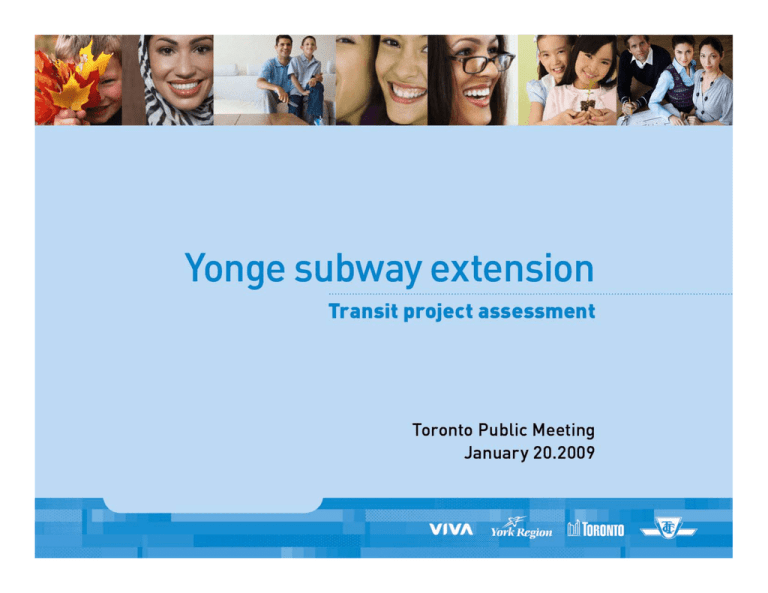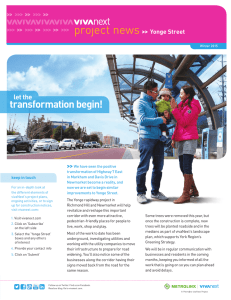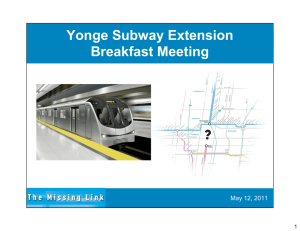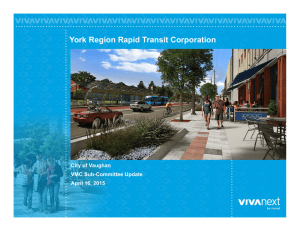Yonge Subway Extension Transit Project Assessment
advertisement

Yonge Subway Extension Transit Project Assessment inter-regional connectivity is the key to success 2 metrolinx: 15 top priorities ● On November 28, 2008 Regional Transportation Plan approved by Metrolinx Board ● Top 15 priorities for early implementation include: ¾ ¾ ¾ ¾ ¾ ¾ Viva Highway 7 and Yonge Street through York Region Spadina Subway extension to Vaughan Corporate Centre Yonge Subway extension to Richmond Hill Centre Sheppard/Finch LRT Scarborough RT replacement Eglinton Crosstown LRT 3 …transit city LRT plan 4 yonge subway – next steps TODAY 5 what’s important when planning this subway extension? You told us your top three priorities were: 1. Connections to other transit 2. Careful planning of existing neighbourhoods and future growth 3. Destinations, places to go and sensitivity to the local environment were tied for the third priority In addition, we need to address all the technical and operational requirements and costs 6 yonge subway at a crossroads ● The Yonge Subway is TTC’s most important asset ● Must preserve and protect existing Yonge line ridership ● Capacity of Yonge line to accommodate ridership growth a growing issue ● Extension of Yonge/Spadina lines matched by downstream capacity ● Three major issues: 1. Capacity of Yonge Subway line 2. Capacity of Yonge-Bloor Station 3. Sequence of events for expansion 7 yonge-university-spadina subway – peak hour volumes 8 yonge subway capacity: history ● Capacity of Yonge line an issue since early 1980s ● RTES study conclusions (2001): ¾Implement new signalling system (ATO/ATC) ¾Allows closer spacing of trains ¾Add a train platform at Yonge-Bloor ¾Construct another line in the downtown core ¾Looping of Yonge/Spadina lines not required with ATO/ATC ● Led to Spadina/Yonge radial extensions to Highway 7 9 yonge subway capacity Historical Ridership Peak 1981: 32,000 40000 Per Hour Capacity 35000 30000 34,000 30,800 32,000 25000 29,700 30,000 Practical Capacity Current Peak Point Ridership 20000 15000 10000 5000 0 Theoretical Capacity 10 yonge subway quality of service ● Significant operational problems; at practical capacity ● Reduced reliability of service ● Passengers left at platforms, especially Yonge-Bloor ● Platform congestion during delays ● Increased passenger complaints ● Recovery from delays more difficult 11 yonge subway / GO rail ridership ● Relationship between the two an important future growth issue ● People make choices for travel downtown: ¾ Speed/frequency of service ¾ Fare levels ¾ Availability /cost of parking ● Other ridership growth issues: ¾ Population growth in 905 ¾ Growth in downtown employment levels ¾ Overall economic/ridership trends ¾ Congestion levels on Yonge line 12 GO rail am peak period ridership – north lines (1980-1999) 13 future growth in yonge subway ridership ● Modelling of future ridership growth a science/art ● To be used with caution for planning purposes ¾ Current peak hour ridership: ¾ 2031 projection (low): ¾ 2031 projection (high): ¾ Net change: 30,000 per hour 37,000 per hour 42,000 per hour +7,000-12,000 per hour ● How can we accommodate this growth? 14 yonge subway am peak hour / peak direction volumes 15 factors contributing to yonge subway growth ● 10% attributable to Transit City Network ● 20% attributable to Yonge Subway extension ● 70% due to: ¾ General population/employment growth ¾ Other service/network improvements ● A network issue of importance to the whole GTA ● Impact of many factors, not one factor 16 TTC/City response to growth and capacity ● a) Short to Medium Term 1. Spadina Subway must open before Yonge Subway extension to divert riders 2. New signalling system must be funded/implemented to improve capacity 3. Capacity of Yonge-Bloor station must be addressed 4. New Toronto Rocket Cars to increase capacity of trains 5. Operate Finch/Richmond Hill service to service York/Toronto riders ● b) Long Term 6. Downtown Relief Line 7. 7th car added to subway trains 17 spadina subway extension 18 1: effect of spadina subway extension ● Spadina Subway extension must open before Yonge Subway extension ● Connects to: ¾ Barrie GO line ¾ Finch LRT ¾ Jane LRT ¾ Highway 407 Transitway ¾ Viva/YRT (Sheppard West Station) (Finch West Station) (Steeles West Station) (407 Station) (Vaughan Corporate Centre) ● Will help “dilute” the ridership on Yonge Subway for people from north/west destined to downtown ● 1,300 peak hour riders diverted to Spadina Subway (4% diversion) 19 2: new signalling system ● Capacity improvements to existing line are urgently needed prior to operating the extension ● Funding commitment to re-signal YUS subway line ($350 million) ● Will significantly increase capacity with closer spacing between trains: Current: 142 seconds With new signal system: 105 seconds (35% increase) 20 3: yonge-bloor station ● Key to improving Yonge Subway capacity ● Bottleneck to adding more trains, with existing or new signalling system ● Must cut train ‘dwell’ time in half ● Add a third platform at Yonge Subway level ¾ Train doors will open on both sides ¾ Unload to new centre platform ¾ Load from relocated side platform ¾ Unloading/loading at the same time! ¾ Will cut theoretical dwell time by 50% ● Could also add platforms on BD level 21 congestion at yonge-bloor station 22 yonge-bloor station: third platform concept (interim) 23 yonge-bloor station: third platform concept (ultimate) 24 3: yonge-bloor capacity study ● Initiated in January 2009 ● To be completed by Fall 2009 ● Confirm previous concepts for expansion ● Identify other operational strategies to increase capacity ● $450 million project ● Currently not funded ● 4-5 years to design/construct ● Station will be operational throughout construction 25 4: new toronto rocket cars ● New trains will allow riders to walk/stand in between each car: ¾ 10% increase in train capacity ¾ Better distribution of passengers along train length ● Currently on order for delivery by 2012 ¾ Prior to opening of Spadina or Yonge Subway extensions 26 4: interior of new toronto rocket car 27 5: yonge subway extension: planned service levels AM Rush Hour Downsview – Finch: 2 minutes 21 seconds Downsview - Richmond Hill Centre: 4 minutes 42 seconds PM Rush – Initially Downsview - Richmond Hill Centre: 2 minutes 21 seconds 28 5: yonge subway: initial service levels ● Every second northbound train will short-turn at Finch station ● These trains will be empty for southbound departures at Finch station ¾ For local Finch riders with extension ● Every other train will start at Richmond Hill Centre station ¾ Will capture ridership north of Finch Station ● Helps to increase seat availability south of Finch in AM Rush 29 6: downtown relief line ● Long-term option (Pape to Queen) ● Diverts 40% of Yonge riders to new line (Metrolinx estimate) ● Yonge peak hour ridership reduced to 25,000 per hour ● A last resort after maximizing capacity of existing system ● $2.1 billion project 30 7: longer subway trains ● Existing platforms are 500 foot long ● Existing trains are 450 foot long ● 50 foot allowance for drivers to manually stop the train ● With new signal system, computer will stop the train ● One foot stopping allowance with ATO/ATC ● Allows the operation of longer trains ● 10% improvement in capacity ● Significant operational impacts to implement ● A long term option 31 improved GO service levels ● Increased service levels in GO rail corridors essential ¾ Especially Richmond Hill GO corridor ● Potential to offload Yonge ridership ● Both GO service improvements and Yonge extension are required ● Each serves a different travel market ● Need both improvements, not one or the other 32 capacity improvements to the yonge line 33 timeline for yonge subway capacity / ridership milestones 34 theoretical capacity and ridership 35 theoretical capacity and ridership 36 theoretical capacity and ridership 37 Presenting Your Yonge Subway Extension Project… subway construction techniques 39 cut-and-cover process 40 traffic management during construction at stations 41 the final yonge subway project includes… ● Six stations ● Two intermodal Terminals ¾ Steeles & Yonge ¾ Richmond Hill Centre ● Bridge over East Don River ● Park-and-Ride facilities for 2,000 cars at Langstaff/ Longbridge 42 benefits of yonge subway northerly extension ● Southbound buses destined to Finch Station will now go to Steeles Station ¾ Significant reduction in bus volumes on Yonge St. ¾ Reduced noise, fumes, bus traffic on Yonge St. ¾ Local Yonge bus service will remain ● Two new stations (Cummer/Drewry and Steeles) ¾ Improved bus and walk-in access to new stations ¾ New bus terminal at Steeles ● Allows opportunities for Finch Station surface facilities to evolve/develop and consolidate bus terminal ● Improved availability to Finch Station commuter lots 43 yonge street bus volumes (finch – steeles) Number of Buses in Peak Period/Direction (SB) (6 – 9 am) Current With Yonge Subway Extension 370 6 44 construction overview 45 what comes with a subway? • • • • • • • • Te passenger pick-up and drop-off entrances bus terminals parking electrical substations emergency exit buildings vent shafts Te 46 toronto station requirements Station # of Electrical Commuter Bus Facilities Entrances Substation Parking Cummer/Drewry 2 No No Bus loop only Steeles 2-3 Yes No Bus terminal (25 bays) 47 justification for cummer/drewry station ● Threshold of 100 persons per hectare (pph) ● At or above this level = successful transit station ¾ Cummer/Drewry currently at 82 pph ● Station will meet the threshold close to opening day 48 cummer/drewry station 49 part of the north york centre plan 50 steeles station - underground bus terminal ● Maximizes passenger convenience ● Minimizes bus operating costs ● Reduces bus travel time ● Best possible transit oriented development opportunities ● Reduces property acquisition costs ● Offers negligible difference in longterm maintenance costs over other options considered ● Anticipate less business impact ● Accommodates future rapid transit along Steeles Avenue 51 steeles station – concourse / bus level 52 major project costs 53 potential additional network costs Project Capital Cost Need / Justification $450 million Transit City, Yonge Extension, New signal system, Growth, Intensification Subway Fleet Expansion $168 - $252 million Same as above plus Spadina Spadina/Yonge fleet (already in project budgets) Second entrances to Downtown Stations Up to $15 million per station 5 stations already included in TTC budget Yard Expansion New Yard: $350 - $450 million Satellite Yard: $150 - $250 million All of the above Downtown Relief Line $2.1 billion All of the above Sheppard Subway Extension (Yonge-Downsview) $1.4 billion All of the above Yonge-Bloor Expansion 54 capital cost estimates and timeline 55 next steps for City of toronto & TTC ● To TTC Commission for approval on January 21 ● To Toronto Council for approval on January 27-28 ● Environmental Project Report submission to Ministry of Environment in February 56 staff recommendations ● Approve project concept and authorize submission of the project report to Ministry of the Environment ● Funding, service and other agreements required on the basis of the following principles: ¾ City will not be liable for any capital costs and increases in net operating costs related to the project ¾ TTC will be project manager for project ¾ TTC will own, operate and maintain property, assets, subway facilities in York Region except bus terminals, PPUDOs 57 staff recommendations ● Spadina Subway Extension and ATO/ATC must be in place prior to opening of Yonge Subway Extension ● Project costs should include those attributable from: ¾ Addressing capacity constraints at Yonge-Bloor station ¾ Rail yard requirements ¾ North York service road 58 TTC recommendations ● TTC’s base capital funding must continue to be fully funded including replacement streetcars, and the timely implementation of Transit City lines ● TTC’s future base capital funding needs for rail yard expansion, expanded subway car fleet to support reduced headways on YUS line and increased capacity of Yonge-Bloor station must also be funded ● The above ‘requirements’ must be met 59 Thank You clark station 61 east don river bridge crossing ● Allows for shallow, relatively flat subway tunnel that will be operationally least costly ● Allows for a shallow subway station at Royal Orchard – easier pedestrian access, quicker emergency response Vaughan Mills Bridge ● Opportunity to reduce the slope on Yonge Street for pedestrians and drivers ● Opportunity to naturalize the valley John Street Bridge 62 east don river bridge crossing 63 east don river bridge crossing Concept drawing only 64 royal orchard station 65 langstaff/longbridge station 66 design features that address concerns • Bicycle and pedestrian paths • Noise buffers • Maintain a green corridor • Bio-swales • Sustainable treatments for parking • Protection of natural environment 67 key considerations at richmond hill centre 407 transitway subway GO train GO bus YRT/ Viva 68 richmond hill centre terminal 69


